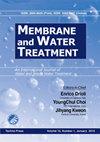污秽纳滤膜处理纺织印染废水的性能研究
IF 0.8
4区 工程技术
Q4 ENGINEERING, CHEMICAL
引用次数: 5
摘要
采用埃及El-alamia印染织造厂的活性黑色染料RB5 (Pt/Co色浓度为1500,TDS含量为16890 mg/l)废水对纳滤膜的污染进行了研究。NF-unit在恒压10 bar,温度25℃,流量420 L/min的条件下运行。用SEM, EDX和FTIR对污垢进行表征。使用ROIFA-4程序,总无机污染负荷为1.07 mM/kg,其中49.3%的碳酸盐、10.1%的硫酸盐、37.2%的硅酸盐、37.2%的磷酸盐和0.93%的氧化铁。污染后染料分子的渗透通量、回收率、除盐率和传质系数均显著降低。结果清楚地表明,污染对膜去除染料的性能有不利影响,渗透通量急剧下降,染料回收率下降68%。染料传质系数降低了34%,盐渗透率提高了14%。在本研究中,确定了所使用的膜的所有特性以及导致其不良状况的污染。另一篇文章(Abdel-Fatah et al. 2017)再次通过化学方法对污染膜进行了再生研究。本文章由计算机程序翻译,如有差异,请以英文原文为准。
Performance of fouled NF membrane as used for textile dyeing wastewater
The fouling of Nanofiltration membrane (NF) was examined using wastewater containing reactive black dye RB5 of 1500 Pt/Co color concentrations with 16890 mg/l TDS collected from El-alamia Company for Dying and Weaving in Egypt. The NF-unit was operated at constant pressure of 10 bars, temperature of 25°C, and flowrate of 420 L/min. SEM, EDX, and FTIR were used for fouling characterization. Using the ROIFA-4 program, the total inorganic fouling load was 1.07 mM/kg present as 49.3% Carbonates, 10.1% Sulfates, 37.2% Silicates, 37.2% Phosphates, and 0.93% Iron oxides. The permeate flux, recovery, salt rejection and mass transfer coefficients of the dye molecules were reduced significantly after fouling. The results clearly demonstrate that the fouling had detrimental effect on membrane performance in dye removal, as indicated by a sharp decrease in permeate flux and dye recovery 68%. The dye mass transfer coefficient was dropped dramatically by 34%, and the salt permeability increased by 14%. In this study, all the properties of the membrane used and the fouling that caused its poor condition are identified. Another study was conducted to regeneration fouled membrane again by chemical methods in another article (Abdel-Fatah et al. 2017).
求助全文
通过发布文献求助,成功后即可免费获取论文全文。
去求助
来源期刊

Membrane Water Treatment
ENGINEERING, CHEMICAL-WATER RESOURCES
CiteScore
1.90
自引率
30.00%
发文量
0
审稿时长
>12 weeks
期刊介绍:
The Membrane and Water Treatment(MWT), An International Journal, aims at opening an access to the valuable source of technical information and providing an excellent publication channel for the global community of researchers in Membrane and Water Treatment related area. Specific emphasis of the journal may include but not limited to; the engineering and scientific aspects of understanding the basic mechanisms and applying membranes for water and waste water treatment, such as transport phenomena, surface characteristics, fouling, scaling, desalination, membrane bioreactors, water reuse, and system optimization.
 求助内容:
求助内容: 应助结果提醒方式:
应助结果提醒方式:


